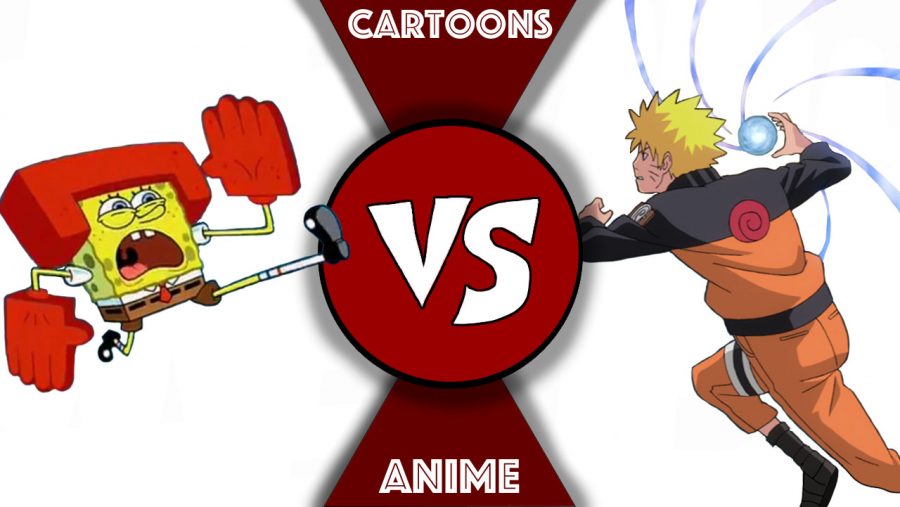The True Depth Behind Anime
What Sets Anime Apart From Cartoons
Naruto Uzumaki from ‘Naruto: Shippuden’, Spongebob Squarepants from ‘Spongebob Squarepants’, Nickelodeon, Pierrot
March 1, 2021
Anime. A genre of animation that has captured the eyes of many simply by having an engaging plot and characters that relate to the viewers on a deeper level, compared to other animation.
As a medium when it comes to storytelling, both manga (which is usually the original source) and anime offer a lot of flexibility for their creators primarily due to the lack of preconceived notions, beliefs, and pressure from publishers. To a simpler understanding, most of the manga series you see nowadays are created by regular people, people who pursued manga as a hobby or a passion. Seeing as how the authors of the source material are not restricted, or limited, by their publisher or any pressure from the community, they have more freedom to create an environment that does not impose on their ideas. As a result, this is what gives anime severe themes and topics, as well as relatable characters, along with its comedy and tropes.
Take a moment and ask yourself: have you ever wanted to visit Japan? Well, when it comes to exploring other cultures, anime is an incredible getaway into the many different lifestyles that Japanese people live. And even though anime is not necessarily the best representation of Japanese lifestyles, customs, and cultures, it does however make indisputable references to it. Since it is very different from what many people are used to, anime piques the interest of many and invites them to learn more about the message beneath the show.
Despite anime essentially being an animated cartoon, there are actually many anime series and films that explore mature or more serious themes with relatable characters. It is similar to watching a serious drama series with the exception that most themes such as depression and suicide, are not always censored. This is very different compared to popular American animation which tends to be more comical, laid-back, and very much apart from reality.
When it comes to anime, it does not cut corners when it comes to visuals. Visuals and animation are what makes anime so unique and fresh. The visuals are the first thing you look at which the exception of how the backgrounds and the environment and how it grabs your attention compared to regular films, the character designs that have been made to be perfect and completely beautiful, and the facial expressions whether the characters are serious or for comedic purpose. Despite anime is not necessarily “realistic” compared to regular entertainment, it manages to find a way to incorporate a form of realism. It is the perfect medium between realistic TV and cartoons.
Anime is also well-known for its incredible action scenes. No supernatural film can beat the action in an anime series. You might ask yourself, but why not? Simply put, the effects, animation, and features make the action unbelievably good in comparison. Animes such as ‘Akame Ga Kill’, ‘Dragon Ball Z’, ‘Naruto’, ‘Demon Slayer’, ‘Sword Art Online’, and ‘Attack on Titan’ uphold this belief. These are just only a few shows with outstanding action scenes, and battles you will enjoy.
Even celebrities are immersed in the genre itself. Whether anime has inspired the lives of some, or are just a source of thought, anime certainly has an impact. Some celebs even relate to characters from anime as they either relate to the character’s hardships or personality, or they look up to the character. Michael B. Jordan is very vocal about his love for anime. He even launched a collection inspired by his favorite anime, Naruto: Shippuden, for a collaboration with Coach. “Anime is something that was a big piece of my childhood, my adult life, and my creativity,” Jordan commented.
Anime illustrations are known to be exaggerated as far as physical features are concerned. Usually, one can differentiate anime from a cartoon by observing the physical traits of the characters. Anime characters include “large eyes, big hair and elongated limbs” and — in the case of manga (anime comics) — “dramatically shaped speech bubbles, speed lines and onomatopoeic, exclamatory typography.”
Cartoons, however, approximate reality a little more and carry traces of day-to-day life in them. Striking resemblances to humans can be spotted in various cartoons. However, cartoon characters are still caricatures, so they often diverge from reality (for example, Marge Simpson’s large, blue hair or Brian, the talking dog, on Family Guy).
Facial expressions for anime characters are often different in form than their counterparts in western animation. For example, Embarrassed or stressed characters produce a massive sweat-drop (which has become one of the most widely recognized motifs of conventional anime). Characters that are shocked or surprised perform a “face fault”, in which they display an extremely exaggerated expression. Angry characters may exhibit a “vein” or “stress mark” effect, where lines representing bulging veins will appear on their forehead. Angry women will sometimes summon a mallet from nowhere and strike another character with it, mainly for comic relief. Male characters will develop a bloody nose around their female love interests, typically to indicate arousal. Characters who want to childishly taunt someone may pull an “akanbe” face by pulling an eyelid down with a finger to expose the red underside.
Anime and cartoons both use traditional animation production processes of storyboarding, voice acting, character design, and cell production. Anime is often considered a form of limited animation i.e. common parts are re-used between frames instead of drawing each frame. This fools the eye into thinking there is more movement than there is, and lowers production costs because fewer frames need to be drawn.
Anime scenes place an emphasis on achieving three-dimensional views. Backgrounds depict the scenes’ atmosphere. For example, anime often puts emphasis on changing seasons, as can be seen in numerous anime, such as ‘Tenchi Muyo!’.
Cartoons are usually intended to induce laughter; thus revolve around humorous concepts. There are some cartoons in the market that are educational in nature whilst retaining their amusing qualities that are generally targeted towards toddlers and kids.
Anime movies don’t always follow a general concept. Their stories can range from pirate attacks to humorous adventures to tales of samurai. The majority of anime movies and shows differentiate themselves from their American counterparts by creating a plot that stays in place throughout the entire series, showing viewers morals and a certain level of complexity. Anime is aimed at people with longer attention spans who like to see a plot unravel over multiple episodes.
“Chihiro’s growth into a capable individual is a core factor to the movement of Spirited Away’s plot. During her adventure in the Spirit World, she matures from an easily scared girl with a child-like personality to match her age to a hard-working, responsible and brave young girl who has learned to put her fears aside for those she cares for…” explains singer Ariana Grande as she unveiled a new tattoo of Chihiro from ‘Spirited Away’. “To protect her friends and rescue her parents from a spell that has turned them into livestock, Chihiro sheds her former personality and adapts to her environment to become a courageous, quick-witted and reliable girl.”



